The Story Behind the CochleaSM Redesign of the Bowers and Wilkins Nautilus Loudspeaker
as well as the Bowers and Wilkins Nautilus 801
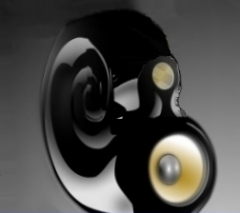
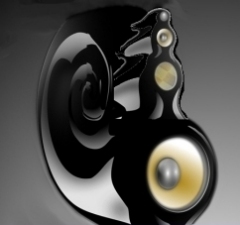
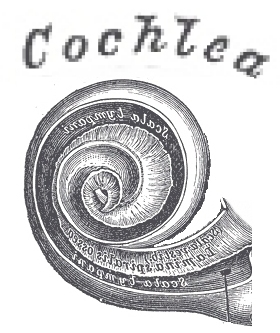
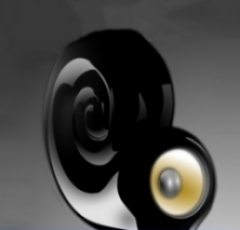
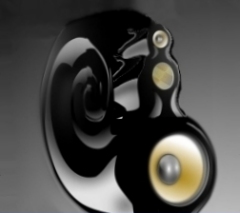
The Story Behind the CochleaSM Redesign of the Bowers and Wilkins Nautilus Loudspeaker as well as the Bowers and Wilkins Nautilus 801 |
     posted 2/20/2015
|
|
Bowers & Wilkins used a great amount
of their ample genius creating the Nautilus, one of the best looking
loudspeakers of all time. When US Enclosure first saw it in the
1990's, the design made us say-- YES. This is GREAT.
Reviewing the design and the name, we realized that B&W was not thinking that the cabinet could resemble a human inner ear and the name B&W chose also reflects this-- Nautilus is the name of marine mollusks with a shell that is an upside-down version of a human Cochlea. B&W both named and copied the design of the mollusk, not the human inner-ear for this cabinet. We thought a loudspeaker cabinet designed as the shape of a human inner-ear (cochlea) is inspired, so we have claimed the shape and executed some preliminary cabinet design work. When we first saw the B&W cabinet, we talked to each other about the Nautilus postured transmission-line rear points as exterior Diffraction Sources. Naturally we are not privy to the details of the drivers and crossover B & W used, but the diffraction from each rear point would be almost impossible to defeat. Yes we realize that the design is a Transmission Line and except for the Woofer, the rear points are for each driver's T-line. But when Form interferes with Function, we feel that the easy correct for B&W for this T-Line design would have been to follow the design model they used for the woofer and spiral each driver's T-Line point to eliminate diffraction. That's what we did. We said to ourselves, this design could be improved acoustically and even used with other drivers IF... 1. Eliminate the rear T-Line points that cause diffraction. 2. Get the bass driver as close to the floor as possible for better bass reproduction. 3. Move the other drivers closer to the woofer and point them upward a bit while keeping them time-aligned with each other and the woofer. So we did a Design Study incorporating these factors onto the B & W Nautilus design, the end-result is what you've viewed. 1. If the unit is a transmission line, wrap all the driver tubes into their cabinet like the woofer. For not transmission line designs, merely enlarge each drivers cabinet as required. 2. Concurrently Flip the bass cabinet so it follows a Cochlea shape* and allowing for the bass driver to be as close to the floor as possible. 3. Keep the driver time-alignment but place the other drivers as close to the bass driver as possible. * Inner-Ear Cochlea's have the entrance at the bottom rather than the top of the spiral. Another one of the Design Study goals was to create a design that could be manufactured for models sold across the board from for a manufacturer marketing to highest-end dealers to manufacturer's aiming products for Walmart level. Recall, the Bowers & Wilkins Nautilus originally cost $60,000. A $100 dollar unit will not come close to the sound of the $60,000 unit but in the Cochlea cabinet it will sound better than any other $100 unit. Same with $1000 units. Even in the 1990's we noticed 2 additional elements we took into consideration with our redesign. Our initial view of the Nautilus reminded us of a human inner-ear cochlea. Yet B&W did not model their cabinet on a human cochlea as the human cochlea wide point is located at the bottom of the organ but B & W modeled the nautilus mollusk (hence their name) that has the loudspeaker cabinet's wide opening (and the bass driver) at the top of the spiral. We also noted B&W named their system the Nautilus--after the spiral seashell species which leads one to believe that the name may have been deliberately chosen. In fact. the B&W bass cabinet is opposite the design of a human cochlea, thus "Cochlea" does not describe their cabinet. Nautilus perfectly describes the B&W cabinet shape. Cochlea perfectly describes the loudspeaker cabinets by US Enclosure Design. We do not claim the Cochlea creates better loudspeaker sound because it models the human cochlea. Our design merely addresses fundamental acoustic issues with the Nautilus in a unique way. And our loudspeaker cabinet design is a direct model of the human cochlea. For loudspeaker cabinets designed or shaped with the human cochlea or inner-ear in mind, All Rights Reserved
| 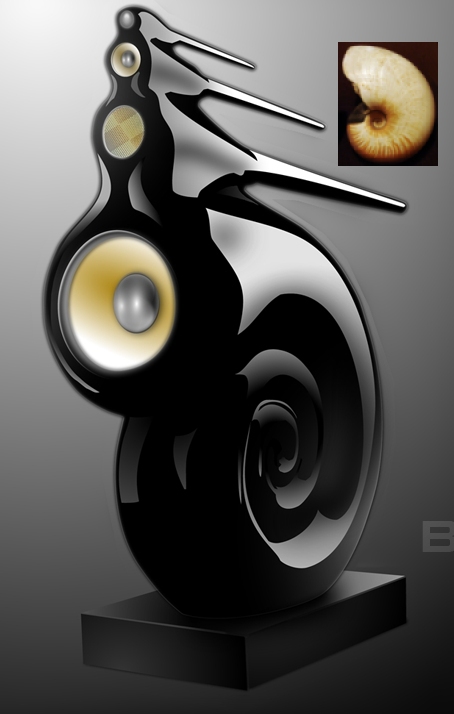 |
||
| Bowers and Wilkins Nautilus 801 Redesign The B and W Nautilus 801 was their adaptation
of the Nautilus concept "reduced" to high-end users budgets.
Sterling Sound Mastering Studio's in New York City used these speakers
for sound mastering even though 801's use a 3rd order crossover (1). B&W
focused on curving the Midrange and High Frequency driver cabinets and
left the 15" woofer cabinet as a rectangular shape; reducing diffraction
effects for low frequencies require huge curved cabinets. However
curving Woofer and Subwoofer cabinets offer measurable acoustic
benefits excluding low range diffraction reduction effects.
(1) Curving the low end cabinet reduces midrange and high frequency drivers output reflection-to-diffraction effects from the the box-shaped low frequency driver cabinet. (2) Curving any cabinet increases the wall stiffness. This can be a plus for low frequency cabinets when applied properly using additional, more flexible cabinet wall materials. US Enclosure can manufacture the shape expressed in the following image. We believe that curving the bass cabinet with this design offers the following benefits compared to the B&W product:
As one of the senior engineers at New York's Sterling Sound, Chris Gehringer has mastered some of the biggest hip-hop and R&B hits of recent years. Chris's Mastering monitoring is a stereo pair of B&W's flagship speakers, the passive Nautilus 801s, driven by seriously large (and expensive) Classe Omega power amplifiers. http://www.soundonsound.com/sos/jun03/articles/chrisgehringer.asp US Enclosure can design a similar product for your company, using the existing drivers, your current cabinet sizes,
and also assist with any necessary crossover adjustments created by lower cabinet diffraction. |
|||
 |